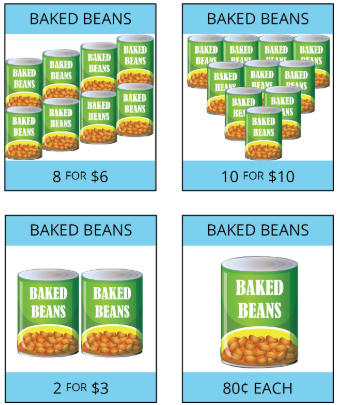17.1: Comparing Speeds and Prices
( \newcommand{\kernel}{\mathrm{null}\,}\)
Lesson
Let's compare some speeds and some prices.
Exercise 17.1.1: Closest Quotient
Is the value of each expression closer to 12,1, or 112?
- 20÷18
- 9÷20
- 7÷5
Exercise 17.1.2: More Treadmills
Some students did treadmill workouts, each one running at a constant speed. Answer the questions about their workouts. Explain or show your reasoning.
- Tyler ran 4,200 meters in 30 minutes.
- Kiran ran 6,300 meters in hour.
- Mai ran 6.3 kilometers in 45 minutes.
- What is the same about the workouts done by:
- Tyler and Kiran?
- Kiran and Mai?
- Mai and Tyler?
- At what rate did each of them run?
- How far did Mai run in her first 30 minutes on the treadmill?
Are you ready for more?
Tyler and Kiran each started running at a constant speed at the same time. Tyler ran 4,200 meters in 30 minutes and Kiran ran 6,300 meters in 12 hour. Eventually, Kiran ran 1 kilometer more than Tyler. How much time did it take for this to happen?
Exercise 17.1.3: The Best Deal on Beans
Four different stores posted ads about special sales on 15-oz cans of baked beans.
- Which store is offering the best deal? Explain your reasoning.

- The last store listed is also selling 28-oz cans of baked beans for $1.40 each. How does that price compare to the other prices?
Summary
Diego ran 3 kilometers in 20 minutes. Andre ran 2,550 meters in 17 minutes. Who ran faster? Since neither their distances nor their times are the same, we have two possible strategies:
- Find the time each person took to travel the same distance. The person who traveled that distance in less time is faster.
- Find the distance each person traveled in the same time. The person who traveled a longer distance in the same amount of time is faster.
It is often helpful to compare distances traveled in 1 unit of time (1 minute, for example), which means finding the speed such as meters per minute.
Let’s compare Diego and Andre’s speeds in meters per minute.
| distance (meters) | time (minutes) |
|---|---|
| 3,000 | 20 |
| 1,500 | 10 |
| 150 | 1 |
| distance (meters) | time (minutes) |
|---|---|
| 2,550 | 17 |
| 150 | 1 |
Both Diego and Andre ran 150 meters per minute, so they ran at the same speed.
Finding ratios that tell us how much of quantity A per 1 unit of quantity B is an efficient way to compare rates in different situations. Here are some familiar examples:
- Car speeds in miles per hour.
- Fruit and vegetable prices in dollars per pound.
Glossary Entries
Definition: Unit Price
The unit price is the cost for one item or for one unit of measure. For example, if 10 feet of chain link fencing cost $150, then the unit price is 150÷10, or $15 per foot.
Practice
Exercise 17.1.4
Mai and Priya were on scooters. Mai traveled 15 meters in 6 seconds. Priya travels 22 meters in 10 seconds. Who was moving faster? Explain your reasoning.
Exercise 17.1.5
Here are the prices for cans of juice that are the same brand and the same size at different stores. Which store offers the best deal? Explain your reasoning.
Store X: 4 cans for $2.48
Store Y: 5 cans for $3.00
Store Z: 59 cents per can
Exercise 17.1.6
Costs of homes can be very different in different parts of the United States.
- A 450-square-foot apartment in New York City costs $540,000. What is the price per square foot? Explain or show your reasoning.
- A 2,100-square-foot home in Cheyenne, Wyoming, costs $110 per square foot. How much does this home cost? Explain or show your reasoning.
Exercise 17.1.7
There are 33.8 fluid ounces in a liter. There are 128 fluid ounces in a gallon. About how many liters are in a gallon?
- 2
- 3
- 4
- 5
Is your estimate larger or smaller than the actual number of liters in a gallon? Explain how you know.
(From Unit 3.2.3)
Exercise 17.1.8
Diego is 165 cm tall. Andre is 1.7 m tall. Who is taller, Diego or Andre? Explain your reasoning.
(From Unit 3.2.2)
Exercise 17.1.9
Name an object that could be about the same length as each measurement.
- 4 inches
- 6 feet
- 1 meter
- 5 yards
- 6 centimeters
- 2 millimeters
- 3 kilometers
(From Unit 3.2.1)

